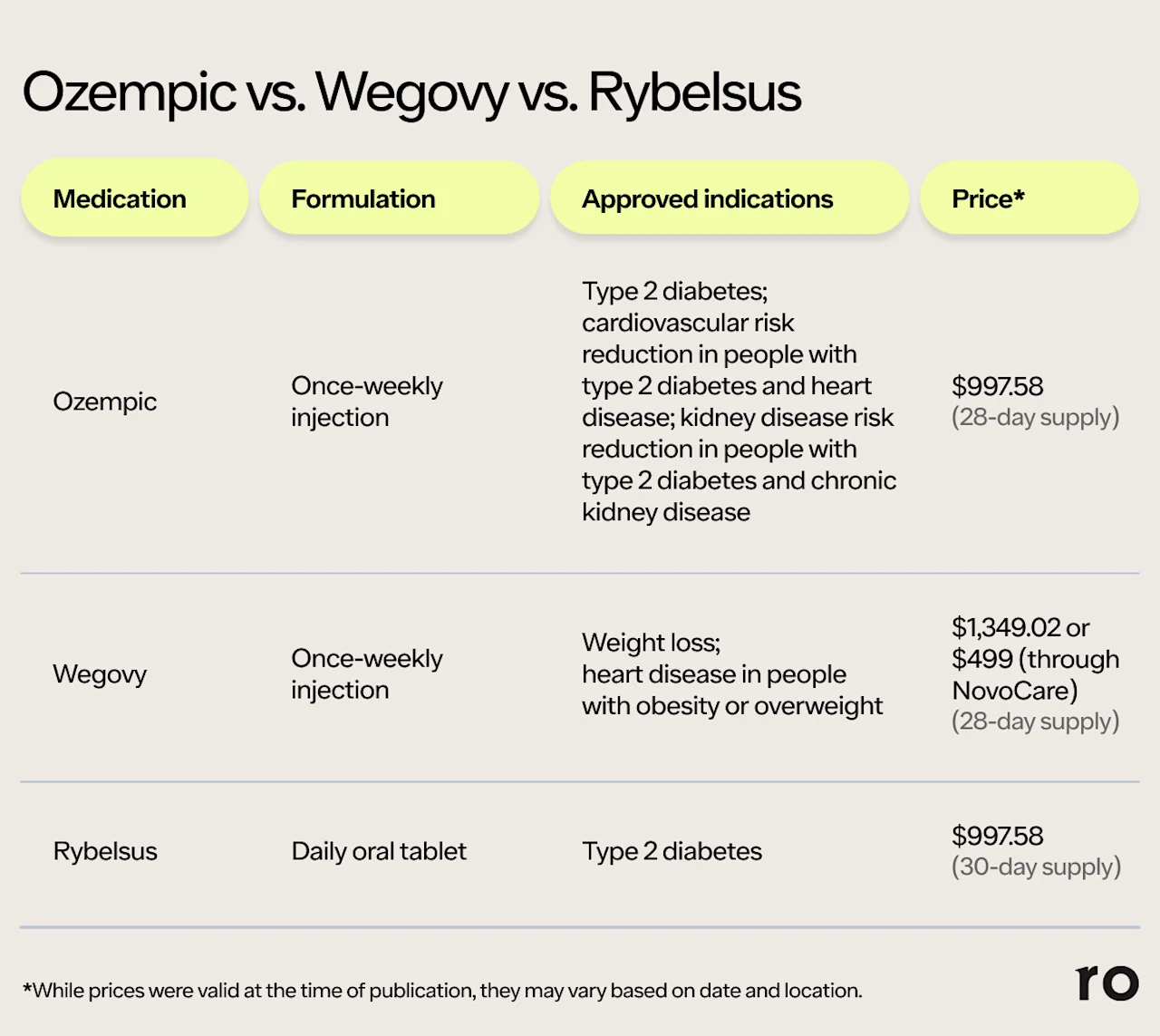Key takeaways
Ozempic costs about $997.58 for a one-month supply, but there are ways to reduce those costs.
Some insurance providers will cover some or all of the cost of the medication, depending on the level of coverage you have and the condition for which the medication is being prescribed.
Here's what we'll cover
Key takeaways
Ozempic costs about $997.58 for a one-month supply, but there are ways to reduce those costs.
Some insurance providers will cover some or all of the cost of the medication, depending on the level of coverage you have and the condition for which the medication is being prescribed.
How much does Ozempic (semaglutide) cost? The answer depends on several factors. If you qualify for insurance coverage, Ozempic can cost as little as $25 for a monthly supply. Without insurance, the cost of Ozempic is just under $1,000 per month.
Ozempic is a prescription medication that is FDA-approved to treat type 2 diabetes in combination with diet and exercise. It’s also approved to lower the risk of cardiovascular problems in people with type 2 diabetes and heart disease. It may also be prescribed off-label for weight loss.
If you are prescribed it, how much you ultimately pay for Ozempic will depend on several key factors, including whether you have insurance coverage for Ozempic or if you’re eligible for certain discount programs through the manufacturer of Ozempic.
Figuring out the cost of Ozempic may feel daunting, but the good news is that once you determine your insurance coverage (Ro can help for free!) and whether you qualify for Ozempic discount programs, the price you will pay is pretty straightforward.
How much does Ozempic cost without insurance?
If you don’t have insurance, how much will Ozempic cost? The answer is not cheap. Without insurance, a one-month supply of Ozempic costs around $995 according to GoodRx.
To get a better idea of how the price of Ozempic may vary, here’s a list of prices from several pharmacies for a .5mg pen, according to SingleCare. Note: Ozempic prices may change and are accurate as of the time of publication. They may vary based on your zip code.
CVS | $870.07 |
Walgreens | $831.83 |
Walmart | $851.48 |
Costco | $962.99 |
How much does Ozempic cost with insurance?
The cost of Ozempic with insurance depends on your plan. Depending on your coverage, you may need to meet your deductible first or pay a copay. If your insurance covers Ozempic, you may pay as little as $25 for a month.
Often, when prescribed specifically for weight loss, Ozempic is not covered by insurance. However, it may be covered as a treatment for type 2 diabetes. On a case-by-case basis, a provider may appeal an insurance company’s decision and make the case that Ozempic is medically necessary and should be covered.
If your health insurance plan does not cover Ozempic, an alternative GLP-1 medication might be available.
Does Medicaid cover Ozempic?
Some Medicaid plans cover medications like Ozempic and other GLP-1 drugs. To see if Ozempic is covered by your Medicaid plan, visit the website for your state’s Medicaid program. You must meet certain eligibility requirements to be covered by Medicaid, such as having a low income. Some drugs may require prior authorization by the insurance provider to be covered under Medicaid.
Does Medicare cover Ozempic?
Most Medicare prescription drug plans cover Ozempic when prescribed for certain diagnoses, including Medicare Advantage Prescription Drug Plans (MA-PD) and Medicare Part D. While many Medicare plans cover Ozempic and other GLP-1 medications, the Ozempic price you pay will depend on your copay and whether you have met your deductible.
To check if your Medicare prescription drug plan covers Ozempic, take a look at your plan’s formulary. This lists all the drugs covered by your plan and their associated tier, which can give you an idea of whether it will be more or less expensive. The higher the tier, the more expensive the medication.
If your plan covers Ozempic but other GLP-1 drugs are listed in a different tier at a lower cost, your healthcare provider may be able to request an exception to get you a lower copay for Ozempic. If not, prescribing one of the other GLP-1 medications may be an option, depending on whether your provider believes doing so would be appropriate for you.
Novo Nordisk savings card for Ozempic
Ozempic can be a costly medication, especially if your insurance does not cover it. Novo Nordisk offers a savings card to help bring down the cost of Ozempic, but you must be enrolled in commercial insurance that covers part of the cost of Ozempic to qualify and have a type 2 diabetes diagnosis. If you do qualify, this savings card can allow you to save up to the following on Ozmepic:
$150 per 1-month prescription
$300 per 2-month prescription
$450 per 3-month prescription
How to save on the cost of Ozempic without insurance
If you don’t have insurance coverage, you can still get Ozempics at a cheaper price. Some websites, such as GoodRx, source Ozempic coupons from various retailers — including Costco, CVS, Walgreens, and Walmart — which can help you save on the cost of Ozempic. With some pharmacies, ordering a 90-day supply of Ozempic may be cheaper per dose than ordering a one-month or two-month supply.
Hear from Ro patients
Ro members taking branded GLP-1 medications were paid for their testimonials.
Can you get Ozempic for free?
Yes, in some instances, you can get Ozempic for free. Novo Nordisk also offers a patient assistance program that provides Ozempic at no cost. To be eligible, you must be a U.S. citizen or legal resident with a total household income at or below 400% of the federal poverty line. You must also not have insurance, Medicare, or any other federal, state, or government program such as Medicaid or VA benefits. You must also have a diagnosis of type 2 diabetes to qualify.
Here, you can check to see whether you qualify under the federal poverty guidelines. Once you apply for the program, you can expect to hear back from Novo Nordisk in about two weeks.
How to get prescribed Ozempic
Ozempic is a prescription medication, so you’ll need a prescription to get it. One option is to make an appointment with your healthcare professional. They can help you assess whether Ozempic is the best option for your weight loss goals or if you should try another GLP-1 medication.
Ro’s weight loss membership pairs personal coaching with GLP-1 medication to help people lose 15% of their body weight after completing the 12-month program. Though the cost of the medication is not included in the monthly fee, Ro’s insurance concierge will work with your insurance to help get the cost of your GLP-1 medication covered if prescribed. Plus, even if you aren’t a Ro customer, our team will check whether you qualify for insurance coverage for Ozempic or other similar medications for free through the Ro insurance checker.
Are there cheaper alternatives to Ozempic?
Among brand-name GLP-1 medications, Ozempic is one of the more affordable options. It is cheaper than Saxenda, Wegovy, Mounjaro, Trulicity, and Rybelsus. However, if you have commercial insurance, you may qualify for the Zepbound savings offer, which brings the cost of a one-month prescription of Zepbound––another injectable GLP-1 medication––down to $25 (with insurance coverage) or $650 (without insurance coverage) and may be a cheaper option if you’re looking for a medication to help with weight loss (and not type 2 diabetes). Victoza (liraglutide) and compounded semaglutide can be other less expensive alternatives to Ozempic if you do not have insurance coverage.
While these medications are similar, they have a few key differences, including how they work, how effective they are, and the side effects you may experience when using them. Talk to your health provider about the best option for you and your treatment goals.
Cost of Ozempic alternatives
Compounded semaglutide is typically much more affordable than brand-name alternatives to Ozempic.
Compounded medications are legal, but they do not undergo the same review process as their FDA-approved, brand-name counterparts. So, when purchasing compounded semaglutide, it’s important to ensure you are buying it from a licensed compounding pharmacy that complies with both federal and state laws.
Medication | List Price for Monthly Supply | FDA-Approved Indications |
Ozempic (semaglutide) | Type 2 diabetes; cardiovascular risk reduction in people with type 2 diabetes and heart disease; kidney disease risk reduction in people with type 2 diabetes and chronic kidney disease | |
Wegovy (semaglutide) | Weight loss; cardiovascular risk reduction in people with heart disease and obesity or overweight | |
Rybelsus (semaglutide) | Type 2 diabetes | |
Compounded semaglutide | Varies | N/A |
Zepbound (tirzepatide) | $1,086.37 (pen); Starting at $399 for vials | Weight loss; obstructive sleep apnea |
Mounjaro (tirzepatide) | Type 2 diabetes | |
Saxenda (liraglutide) | Weight loss | |
Victoza (liraglutide) | Type 2 diabetes; cardiovascular risk reduction in people with type 2 diabetes and heart disease | |
Metformin (metformin) | $4–$16 | Type 2 diabetes |
All of the Ozempic alternatives listed above are injections, similar to Ozempic—except for two: Rybelsus and metformin. These are oral medications that treat type 2 diabetes. Rybelsus has the same list price as Ozempic. Metformin, on the other hand, is available in brand-name forms (Glumetza, Fortamet), as well as a generic medication, which tends to be more affordable. Above, we’ve listed the average price for 60 tablets of generic metformin 500 mg, according to SingleCare. Your monthly price may vary depending on your metformin dosage.
What is the difference between Ozempic and semaglutide?
Semaglutide is the active ingredient in Ozempic and two other brand-name drugs, Wegovy and Rybelsus. All three medications are prescription drugs, but they differ in approved indications, formulation, and price.
Ozempic
Ozempic is a once-weekly injectable medication. It is FDA-approved to control blood sugar levels in people with type 2 diabetes, in combination with diet and exercise. It’s also FDA-approved to reduce the risk of experiencing a major cardiovascular event (e.g. stroke, heart attack) in people with both type 2 diabetes and heart disease and to reduce the risk of kidney disease progression in people with type 2 diabetes and existing kidney disease. It is not FDA-approved for weight loss, but may be prescribed off-label for this purpose.
The current list price of Ozempic is $997.58 for a 28-day supply.
Wegovy
Like Ozempic, Wegovy is also a once-weekly injectable medication. However, it contains higher dosage amounts of semaglutide and is FDA-approved for weight loss in people with obesity and overweight. Wegovy is also FDA-approved to reduce the risk of experiencing a major cardiovascular event (e.g. stroke, heart attack) in people with both obesity or overweight and heart disease. Like Ozempic, it should be used in combination with lifestyle changes like diet and exercise.
Wegovy is more expensive than Ozempic, with a current list price of $1,349.02 for a 28-day supply. You can also get Wegovy for $499 through the manufacturer’s pharmacy, NovoCare online.
Rybelsus
Unlike Ozempic and Wegovy, Rybelsus is an oral medication. It’s taken once a day in the morning, at least 30 minutes before you eat or drink anything else. It is FDA-approved to treat type 2 diabetes by improving blood sugar control, in combination with diet and exercise.
Rybelsus costs about the same as Ozempic, with a current list price of $997.58 for a 30-day supply.

Ozempic side effects
Ozempic’s side effects are typically digestive in nature, with the most common being:
Nausea
Vomiting
Diarrhea
Abdominal pain
Constipation
These gastrointestinal side effects are usually most intense at the beginning and when increasing your dose. Other, less common side effects may include dizziness, fatigue, or injection site reactions (e.g., rash, discomfort).
In rare cases, Ozempic can cause serious side effects, including:
Pancreatitis (inflammation of the pancreas)
Diabetic retinopathy (vision loss or changes as a complication of type 2 diabetes)
Kidney or gallbladder problems
Severe allergic reaction
Have you tried any weight loss programs or methods in the past?
Yes, but ready to switch
No, but ready to start
Ozempic cost: frequently asked questions
Read below for answers to frequently asked questions (FAQs) about the cost of Ozempic.
How much is a 30-day supply of Ozempic?
How do I get 3 months of Ozempic for $25?
What is a cheaper alternative to Ozempic?
How do I get my insurance to approve Ozempic?
How many Ozempic pens do you need per month?
Why is the Senate investigating the cost of Ozempic?
DISCLAIMER
If you have any medical questions or concerns, please talk to your healthcare provider. The articles on Health Guide are underpinned by peer-reviewed research and information drawn from medical societies and governmental agencies. However, they are not a substitute for professional medical advice, diagnosis, or treatment.
Ozempic Important Safety Information: Read more about serious warnings and safety info.
Mounjaro Important Safety Information: Read more about serious warnings and safety info.
Zepbound Important Safety Information: Read more about serious warnings and safety info.
Saxenda Important Safety Information: Read more about serious warnings and safety info.
Wegovy Important Safety Information: Read more about serious warnings and safety info.
Ahrén, B., Carr, M. C., Murphy, K., et al. (2017). Albiglutide for the treatment of type 2 diabetes mellitus: An integrated safety analysis of the HARMONY phase 3 trials. Diabetes Research and Clinical Practice, 126, 230–239. doi: 10.1016/j.diabres.2017.02.017. Retrieved from https://pubmed.ncbi.nlm.nih.gov/28284167/
Blundell, J., Finlayson, G., Axelsen, M., et al. (2017). Effects of once-weekly semaglutide on appetite, energy intake, control of eating, food preference and body weight in subjects with obesity. Diabetes, Obesity & Metabolism, 19(9), 1242–1251. doi: 10.1111/dom.12932. Retrieved from https://pubmed.ncbi.nlm.nih.gov/28266779/
Bridges, A., Bistas, K. G., & Jacobs, T. F. (2022). Exenatide. StatPearls. Retrieved on Feb. 13, 2023 from https://www.ncbi.nlm.nih.gov/books/NBK518981/
Canadian Agency for Drugs and Technologies in Health (CADTH). (2019). Pharmacoeconomic Review Report: Semaglutide (Ozempic): (Novo Nordisk Canada Inc.): Indication: For the treatment of adults patients with type 2 diabetes mellitus to improve glycemic control, in combination with metformin (second-line treatment), and in combination with metformin and sulfonylurea (third-line treatment) [Internet]. Appendix 1, Cost Comparison. Canadian Agency for Drugs and Technologies in Health. Retrieved on Feb. 13, 2023 from https://www.ncbi.nlm.nih.gov/books/NBK543967/
Chamberlin, S. & Dabbs, W. (2019). Semaglutide (Ozempic) for type 2 diabetes mellitus. American Family Physician, 100(2), 116–117. Retrieved from https://pubmed.ncbi.nlm.nih.gov/31305048/
Collins, L. & Costello, R. A. (2022). Glucagon-like peptide-1 receptor agonists. StatPearls. Retrieved on Feb. 13, 2023 from https://www.ncbi.nlm.nih.gov/books/NBK551568/
Eli Lilly-a. (2024). How much should I expect to pay for Mounjaro?. Retrieved from https://pricinginfo.lilly.com/mounjaro
Eli Lilly-b. (2024). How much should I expect to pay for Zepbound?. Retrieved from https://pricinginfo.lilly.com/zepbound
Eli Lilly-c. (2024). Savings Card, Cost & Coverage Support | Zepbound (tirzepatide). Retrieved from https://zepbound.lilly.com/coverage-savings
GoodRx. (n.d.) Ozempic. Retrieved Feb. 13 from https://www.goodrx.com/ozempic
Mehta, A., Marso, S. P., & Neeland, I. J. (2017). Liraglutide for weight management: a critical review of the evidence. Obesity Science & Practice, 3(1), 3–14. doi: 10.1002/osp4.84. Retrieved from https://pubmed.ncbi.nlm.nih.gov/28392927
Min, T. & Bain, S. C. (2021). The Role of Tirzepatide, Dual GIP and GLP-1 Receptor Agonist, in the Management of Type 2 Diabetes: The SURPASS Clinical Trials. Diabetes Therapy, 12(1), 143–157. doi: 10.1007/s13300-020-00981-0. Retrieved from https://pubmed.ncbi.nlm.nih.gov/33325008/
NovoCare-a. (2024). Ozempic® Cost. Novo Nordisk. Retrieved from https://www.novocare.com/ozempic/let-us-help/explaining-list-price.html
NovoCare-b. (2024). Novo Nordisk Ozempic® (semaglutide) injection 0.5 mg or 1 mg Savings Card. Novo Nordisk. Retrieved from https://www.novocare.com/ozempic/savings-card.html
NovoCare-c. (2024). Novo Nordisk Patient Assistance Program. Novo Nordisk. Retrieved from https://www.novocare.com/diabetes-overview/let-us-help/pap.html
NovoCare-d. (2024). What is the list price for Rybelsus and will it impact me?. Novo Nordisk. Retrieved from https://www.novocare.com/diabetes/products/rybelsus/explaining-list-price.html
NovoCare-e. (2024). What is the list price for Saxenda and will it impact me?. Novo Nordisk. Retrieved from https://www.novocare.com/obesity/products/saxenda/explaining-list-price.html
NovoCare-f. (2024). What is the list price for Wegovy and will it impact me?. Novo Nordisk. Retrieved from https://www.novocare.com/obesity/products/wegovy/let-us-help/explaining-list-price.html
Novo Pricing. (2024). Victoza Pricing. Novo Nordisk. Retrieved from https://www.novopricing.com/victoza.html
Scott, L. J. (2020). Dulaglutide: A Review in Type 2 Diabetes. Drugs, 80(2), 197–208. doi: 10.1007/s40265-020-01260-9. Retrieved from https://pubmed.ncbi.nlm.nih.gov/32002850/
Shah, M. & Vella, A. (2014). Effects of GLP-1 on appetite and weight. Reviews in Endocrine & Metabolic Disorders, 15(3), 181–187. doi: 10.1007/s11154-014-9289-5. Retrieved from https://pubmed.ncbi.nlm.nih.gov/24811133/
U.S. Food and Drug Administration (FDA). (2018). Glumetza (metformin hydrochloride) extended-release tablets, for oral use. Retrieved from https://www.accessdata.fda.gov/drugsatfda_docs/label/2018/021748s025lbl.pdf
U.S. Food and Drug Administration (FDA-a). (2023). Mounjaro (tirzepatide) injection, for subcutaneous use. Retrieved from https://www.accessdata.fda.gov/drugsatfda_docs/label/2023/215866Orig1s002s006lbl.pdf
U.S. Food and Drug Administration (FDA-b). (2023). Ozempic (semaglutide) injection, for subcutaneous use. Retrieved from https://www.accessdata.fda.gov/drugsatfda_docs/label/2023/209637s020s021lbl.pdf
U.S. Food and Drug Administration (FDA-a). (2024). Rybelsus (semaglutide) tablets, for oral use. Retrieved from https://www.accessdata.fda.gov/drugsatfda_docs/label/2024/213051s018lbl.pdf
U.S. Food and Drug Administration (FDA-c). (2023). Saxenda (liraglutide) injection, for subcutaneous use. Retrieved from https://www.accessdata.fda.gov/drugsatfda_docs/label/2023/206321s016lbl.pdf
U.S. Food and Drug Administration (FDA-b). (2024). Victoza (liraglutide) injection, for subcutaneous use. Retrieved from https://www.accessdata.fda.gov/drugsatfda_docs/label/2024/022341Orig1s043lbl.pdf
U.S. Food and Drug Administration (FDA-c). (2024). Wegovy (semaglutide) injection, for subcutaneous use. Retrieved from https://www.accessdata.fda.gov/drugsatfda_docs/label/2024/215256s011lbl.pdf
U.S. Food and Drug Administration (FDA-d). (2024). Zepbound (tirzepatide) injection, for subcutaneous use. Retrieved from https://www.accessdata.fda.gov/drugsatfda_docs/label/2024/217806s005s006s011s015s019lbl.pdf













